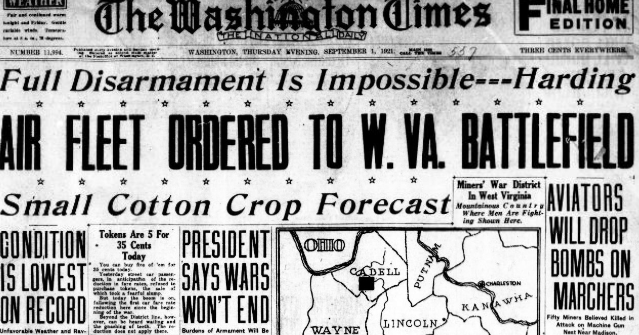

By Chris Clough
One hundred years ago, a five-day bloody battle raged in the US. A million rounds of ammunition were fired, and planes flew overhead dropping bombs and poison gas. This battle, the largest since the Civil War, is rarely mentioned in the history books and the centenary passed by without most politicians even acknowledging it. This is because it was a battle fought by thousands of miners against the mine owners’ private army over the right to join a union.
The Biden administration would no doubt be happy to leave this event buried deep underground, as it exposes the thin veneer of legality and moral superiority that shrouds bourgeois democracy. It is a story of how tens of thousands of workers and their families were terrorised, denied their supposed freedoms and forced to gamble everything in confrontation with their bosses and the state.
To work the mines of West Virginia, mine owners brought in thousands of people from elsewhere. These workers were forced to live in squalid conditions, cut off and isolated from the rest of civilisation, and subjected to the most regimented and oppressive work conditions imaginable. The mining communities were extremely diverse with high numbers of immigrant and black workers.
In 1918 alone 404 West Virginia miners died on the job. Shockingly, the death rate of workers in the mines was higher than that of US soldiers fighting in the trenches of Europe. Pay was low, and the mining companies generally owned all the housing and shops, leaving workers no choice but to pay extortionate rent and food prices. Any miner that stepped out of line would find their family evicted and on the streets with nowhere to go: a powerful tool, often used in retaliation for strike action.
On top of this the company often paid the wages of law enforcement officers and hired from the notorious Baldwin-Felts Detective Agency, a viscously anti-union outfit that specialised in hiring thugs that would happily terrorise families and ‘disappear’ union activists. These company thugs became the law and it was not uncommon for machine guns to be posted outside the mine: the bosses’ answer to the mass picket.
The immediate spark for the Battle of Blair Mountain was the Matewan Massacre of 1920, when pro-union sheriff Sid Hatfield was murdered by Baldwin-Felts agents in broad daylight on the court steps (as depicted in 1987 film Matewan). None of the assassins were imprisoned. News of this event spread like wildfire through the mining settlements.
This blatant act of war, alongside intolerable conditions and the continued imprisonment of unionised miners, was the
spark that set West Virginia ablaze. The union officials could not hold back the tide, as thousands began arming themselves with the intention of marching to Mingo County to release their fellow workers from jail, end martial law and hang the notorious anti-union sheriff, Don Chafin. But Blair Mountain stood in the way, and the company militia, well-funded by the bosses, began to fortify their positions.
The miners commandeered trains, expropriated company supplies and gathered thousands more miners along the way until their numbers swelled to 20,000. The company bosses tried to create divisions along racial lines, but the miners fought against racism within their own ranks. This was of vital strategic importance to ensure the unity of the movement. Company buildings were desegregated as the miners, black and white, marched in and sat down to eat together.
After five days of fighting at Blair Mountain, with up to 130 dead, neither side could make a decisive breakthrough. It was the US military that secured the bosses’ victory, with the airforce and 2,500 troops. The miners’ insurrection, isolated due to the lack of a revolutionary party or powerful trade union movement across the US, could not win against the US army. In defeat, they faced intense repression with 985 arrests, the imposition of martial law on the miners, press censorship across the country and the decimation of the miners’ union.
But it proved to be a pyrrhic victory for the mine owners. Many of the trials collapsed as the brutality of the mine owners was brought to light. After a decade, the militant traditions of the miners were revived, and the mines were finally unionised during the 1930s against the backdrop of factory occupations and mass strikes across the US. This time, the miners were no longer alone; it was the bosses who were on the back foot.
Although it was a hundred years ago, the struggles of these brave workers can be an inspiration for American workers today. Workers like the West Virginia miners, through their sacrifices, won the right to unionise and lasting improvements to the lives of working class Americans. But the bosses and government continue to prosecute the class struggle in the US, beneath that thin veneer of legality, from the repression of the Black Lives Matter protests, the ICE raids and the anti-union tactics of companies like Amazon.
In 2021, as in 1921, millions of workers slave for long hours just to get by and society is polarised, with wealth inequality recently returning to levels last seen in the 1920s. Coal miners are again fighting their greedy bosses — at Warrior Met Coal, workers have been on strike for 5 months. In times like these, workers would do well to remember the sacrifices of those who died at Blair Mountain.